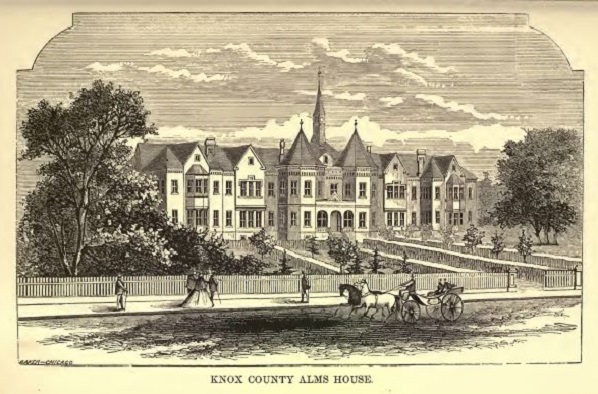November 26, 2018
 From THE HISTORY OF KNOX COUNTY, ILLINOIS, by Chas. E. Chapman & Co., Chicago, 1878, p. 255. |
The Almshouse
By Barbara Schock
On November 30. 1899, the Galesburg Evening Mail published an article by one
of its reporters. He had interviewed John Cook, the manager of the Knox County
Poor Farm at Knoxville. At that time there were 140 patients including sixty
insane persons and five or six children in the residence.
Efforts were made to provide the residents with some holiday experiences. The
Thanksgiving dinner was served at 1:00 pm. It included chicken, cranberry sauce,
pie, cake and gingerbread. Coffee, tea and milk were also available. After the
meal was concluded and the clean dishes put away, the inmates were given time
for recreation. Those who worked had the opportunity to rest. Visitors were also
received.
Mr. Cook explained that most of the inmates were unable to work because they
were elderly, in poor health or insane. There were plenty of jobs in the
community so there weren’t many lazy people asking for a place to stay.
The county almshouses in Illinois began in 1839. They provided the social
services of the day for the elderly, insane, poor, sick, women with young
children and no husband or income as well as men injured in industrial
accidents. After the Civil War there were a few veterans who came to the
almshouse. Some individuals might stay several days, a week or come and go as it
suited them.
In 1856 Cephas Arms (1811-1883), John S. Winter (1822-1893) and Rufus S. Miles
(1822-1894) served on a committee of the County Board of Supervisors (now named
the County Board). The men stated that conditions at the poor farm were
inadequate. The building wasn’t large enough for the number of residents.
One patient, Crazy Hannah, had to be locked in a small room to keep her away
from the heating stove. She had been confined in that room for three years.
In that same year land was purchased in Section 21, Knox County. A two-story
building was erected with ample ventilation, many windows to allow light into
the rooms and supplied with a number of bathrooms. In 1876 a second wing was
added to the facility.
The State Legislature oversaw the performance of all the county homes and farms
so annual reports were prepared by inspectors. The 1881 Knox County report was
quite favorable. The yearly cost of operating the facility was $8250. At that
time there were 105 residents (28 were insane, but none were secluded or
restrained). The inspector stated that the establishment was first class in
every respect.
In 1983 a marble monument was placed on a plot where more than one hundred
inmates had been buried. From 1870 until 1922 almshouse residents had been
buried without markers identifying the graves. Death certificates filed in the
County Clerk’s Office were used to identify the burials. Sometime following that
period the land had been tilled and planted with crops. A record is available at
the Galesburg Public Library.
By 1967 all county poorhouses in Illinois were decommissioned. The Knox County Board chose to continue with a nursing home to serve constituents.